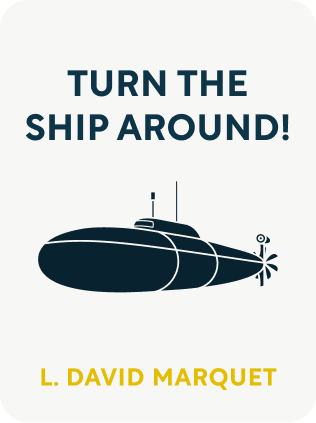

This article is an excerpt from the Shortform book guide to "Turn the Ship Around" by L. David Marquet. Shortform has the world's best summaries and analyses of books you should be reading.
Like this article? Sign up for a free trial here .
How did Captain David Marquet improve competence within his submarine crew? What lessons apply to your organization?
As submarine captain, David Marquet implemented the leader-leader model on Santa Fe, he knew that he would need to find ways to improve competence within his team if they were to take on more and more responsibility and become leaders themselves. He and his officers used five mechanisms to do this.
Read more to learn how to improve competence within a team.
5 Mechanisms to Improve Competence
Decentralizing control under a leader-leader system works only when the people receiving increased control have the technical competence or knowledge to make decisions. Marquet and his officers used the following mechanisms to strengthen the crew’s technical competence:
- Take “deliberate action”: Officers and crew pause before acting and state their intentions to prevent acting without thinking.
- Learn constantly: Officers and crew approached every activity as a chance to learn and improve.
- Demonstrate readiness: Instead of listening to a briefing or review of instructions, crew members demonstrate they’re prepared to proceed.
- Repeat the message of change until it fully sinks in. Old habits die hard.
- Specify goals, but let crew members decide the best methods for reaching them.
In Port, Pearl Harbor (150 Days to Deployment)
On Saturday morning, Santa Fe officers and observers from Squadron Seven and Naval Reactors gathered to critique the petty officer’s “red tag” mistake.
The incident underscored to Marquet that it wasn’t enough for people to be empowered—they also needed to be competent to perform better. To improve competence, he needed to understand what had happened.
Others, however, were focused on accountability. The typical response to a “red tag” violation was a procedure known as a “captain’s mast.” Instead of a trial by court-martial, the captain could impose a nonjudicial administrative punishment, such as forfeiture of pay. While it was important to hold people accountable, Marquet viewed the incident as a symptom of a larger problem.
When he opened the meeting, the first to speak was the petty officer. He said he knew conditions for shutting the breaker had been met, and he moved the red tag aside to do it. He was contrite and candid, admitting to an unexplainable mental lapse when he moved the tag without proper clearance.
Maquet thanked him for his candor and sent him away without a reprimand. He felt the petty officer’s honesty, despite expecting punishment, should earn a reprieve. The bigger issue was how to prevent it from happening again.
Mechanism #1 to Improve Competence: Take ‘Deliberate Action’
They discussed refresher training, but they decided it wouldn’t help since there hadn’t been a lack of knowledge about what to do. They considered adding a layer of supervision, but there was substantial supervision already and it hadn’t stopped the error.
Someone argued that sometimes mistakes just happened. Others said the problem was a lack of attention to detail—but telling people to pay closer attention doesn’t work. The key to coming up with a solution was realizing that the petty officer had been operating on autopilot without engaging his brain.
They came up with a mechanism aimed at getting people to act thoughtfully and deliberately—they called it “take deliberate action.” The way it would work was:
Before taking any operational action, a crew member would pause, verbally state what he intended to do, and gesture toward the controls. The purpose was to engage the operator’s mind and eliminate acting automatically.
Taking deliberate action is a mechanism for improving competence. It was the most powerful step the officers and crew implemented for reducing mistakes and improving operational excellence.
Deliberate action had other benefits in addition to reducing errors. In team activities, the pause and verbal statement allowed others to step in when they saw a problem and prevent it. Similarly, it gave monitors, who were assigned during drills to watch procedures to prevent mistakes, more time to intervene.
A Learning Culture: 136 Days to Deployment
While deliberate action reduces errors, it’s not enough, by itself, to improve competence. For instance, a sailor made a mistake in the torpedo room that deliberate action didn’t prevent—the problem occurred because he didn’t understand the effects of what he was doing and how certain systems worked together.
If crews only have to do what they’re told, they don’t need a deep understanding of how things work—they just follow procedures. But as their ability to make decisions increases, they need greater knowledge on which to base those decisions.
To create an atmosphere that encouraged learning, officers and chiefs came up with a program they called “we learn,” which established learning as a unifying theme for everything crew members did. No matter what they were doing, they should strive to learn as much as possible from it. While life on a submarine didn’t allow time for lectures, it offered numerous learning opportunities, which seemed to pop up everywhere when the officers and crew started looking for them.
Mechanism #2 to Improve Competence: Learn Constantly
Santa Fe’s learning mentality was critical to implementing leader-leader by passing decision-making authority to lower levels. It created a chain of positive effects:
- Learning and training improved competence.
- Greater competence allowed officers to delegate more decision-making.
- Increased decision-making led to greater employee engagement and initiative.
- Productivity, morale, and effectiveness grew.
Learning constantly is a mechanism for improving competence. Inspection teams often commented on the Santa Fe crew’s eagerness to learn.
Questions for Leaders
- What areas of your business are prone to mistakes because employees don’t have the competence to make good decisions?
- How would you create a learning mentality among your staff?
Ready or Not? 127 Days to Deployment
As Santa Fe left the harbor and headed for San Diego for a series of exercises with the USS Constellation Battle Group, Marquet discovered another weakness they could turn into a mechanism for improving competence.
As the crew got ready to submerge the ship, it seemed to be taking a long time—they were out of practice on submerging rapidly, which was a key combat skill. The diving officer of the watch conducted a briefing (read the procedures out loud), but no one paid attention to this formality. Marquet ran some unexpected drills simulating malfunctioning gauges, which didn’t go well.
When they discussed how things went, one sailor remarked that no one listened to briefings because they felt they already knew the steps to take.
Mechanism #3 to Improve Competence: Certify or Demonstrate Readiness
Briefings, or reading procedures out loud before an activity, were a common feature in the Navy. However, they were passive—everyone listened; they had no responsibility to prepare in advance, and it was easy to assent without engaging mentally.
Marquet decided to replace briefings with certifications, in which participants demonstrate readiness and are “certified” to proceed with the task. During certification, a team leader asked the members questions, then decided whether the team was ready to perform the task. It was postponed if the team hadn’t demonstrated the required knowledge.
Everyone was an active participant. The certification process required people to actively review or prepare for their duties. It also placed more responsibility on team leaders, who had to identify the steps needed for the operation and the role of each team member, and determine the level of competency.
The shift from passive briefings to active certifications changed the crew’s behavior. Knowing they’d get questions, crew members prepared ahead of time; the process increased everyone’s intellectual involvement in operations.
Certifying, or demonstrating readiness, is a mechanism for improving competence. It’s also a checkpoint—the task will either proceed if people are ready, or it won’t if they reveal they aren’t ready because of something they don’t know. Anything less is just a briefing.
Questions for Leaders
- How can you make team members responsible for knowing their job?
- How much do your employees prepare before an event or task?
- Describe your last briefing on a project—how did listeners react?
- How could you certify that your project teams know their responsibilities and the goals of an operation?
- How can you take more responsibility as a leader to ensure teams are ready?
Don’t Assume They Got the Message: 116 Days to Deployment
On the way to San Diego, Marquet learned that when you give middle managers control over their teams, you can’t assume they’ll act in the team’s interest. This nearly cost Santa Fe a key crew member.
When they reached the port, a junior quartermaster, nicknamed “Sled Dog” for his work ethic, went AWOL (left the boat without permission), after saying he couldn’t take things anymore. A quartermaster is a naval petty officer with responsibility for steering the submarine and charting its course.
Marquet discovered that the underlying problem was that Sled Dog and the other quartermasters were being overworked. Instead of helping to fill in on watch shifts, the chiefs were choosing the shortest shifts for themselves or not filling in at all.
Marquet was sympathetic to the crew and granted Sled Dog amnesty. Meanwhile, he told the chiefs he was upset that some had used their increased authority to make things easier for themselves instead of looking out for their men. They weren’t “walking the walk” and had demoralized the crew. He imposed an equitable scheduling rule to ensure that supervisors shared in rotations rather than taking better shifts than their crews.
Mechanism #4 to Improve Competence: Repeat the Message
The chiefs’ behavior bothered Marquet—after two months, he thought they were on board with leader-leader, but they’d fallen into old thinking. He decided they needed continuous repetition of the message.
When you launch a new initiative, some people will “get it” immediately; others will be skeptical or need more time to absorb it. The key to breaking through is repeating the message day after day. Repeating the message is a mechanism for improving competence. Even people who are on board emotionally with a change can fall into old habits.
Questions for Leaders
- What messages do you need to keep repeating to make sure your managers take care of their teams?
- Have you ever thought that people understood what you were talking about only to find out later that they didn’t get it?
Achieve Results: 28 Days to Deployment
At sea again, Santa Fe was heading back to San Diego. On the way, they would be practicing drills and operational skills. Final certification for deployment would happen when they reached San Diego. Things were going well, but a fire drill revealed yet another area where following procedure still took precedence over achieving results.
Fire is potentially catastrophic on a submarine. To prevent disaster, crews needed to have hoses on a fire within two minutes. Marquet called a surprise drill and it went poorly. The crew focused on following procedure (in this case, performing assigned duties) rather than putting the fire out. Some ran past a fire hose instead of grabbing it because others were assigned to handle hoses.
Further, typical fire drills were aimed at practicing techniques, which made crews focus on process. They had no incentive to put the simulated fire out as quickly as possible. Marquet decided they needed to refocus fire drills on one objective: getting the fire out the fastest way possible. The results, not the method or process, would be what counted—just as they would in a real-life situation.
Mechanism #5 to Improve Competence: Specify Goals, Not Methods for Reaching Them
To motivate the crew to attack the fire, they adapted drills to the crew’s response. If crews moved quickly to douse the fire in 45 seconds, the drill was over. If they got a hose on the fire in two minutes, the drill ended.
Marquet explained to the crew that the objective was to put the fire out, regardless of who had been assigned to handle the hose. Thereafter, when a fire alarm sounded, the men closest to the simulated fire organized themselves and put it out. The new approach reduced the response time significantly. Santa Fe’s crew became so proficient that they later received awards for their damage control response capability.
Specifying goals, not methods, is a mechanism for improving competence. The crew was given a clear goal—put the fire out as quickly as possible. During a drill or crisis, it was up to the crew members to devise the most effective method.
Ready for Deployment
When Sania Fe picked up the inspectors at San Diego, Marquet felt confident the crew was ready—and he was right. Their performance was outstanding, and Commodore Kenny certified the ship as ready for deployment.
They needed only to return to Pearl Harbor for final preparations and be underway for deployment on June 18—two weeks early.
Questions for Leaders
- Are your people focused on process rather than results?
- When you set goals for your organization, do you also specify the methods for achieving them, or do you leave the methods up to staff?
- How can you refocus your staff on results?

———End of Preview———
Like what you just read? Read the rest of the world's best book summary and analysis of L. David Marquet's "Turn the Ship Around" at Shortform .
Here's what you'll find in our full Turn the Ship Around summary :
- How a captain turned the U.S. Navy’s worst-performing nuclear submarine crew into one of the best
- The principles for developing leaders at all levels to create a passionate, high-performing workforce
- Why the "leader-leader" model works better than the "leader-follower" model






